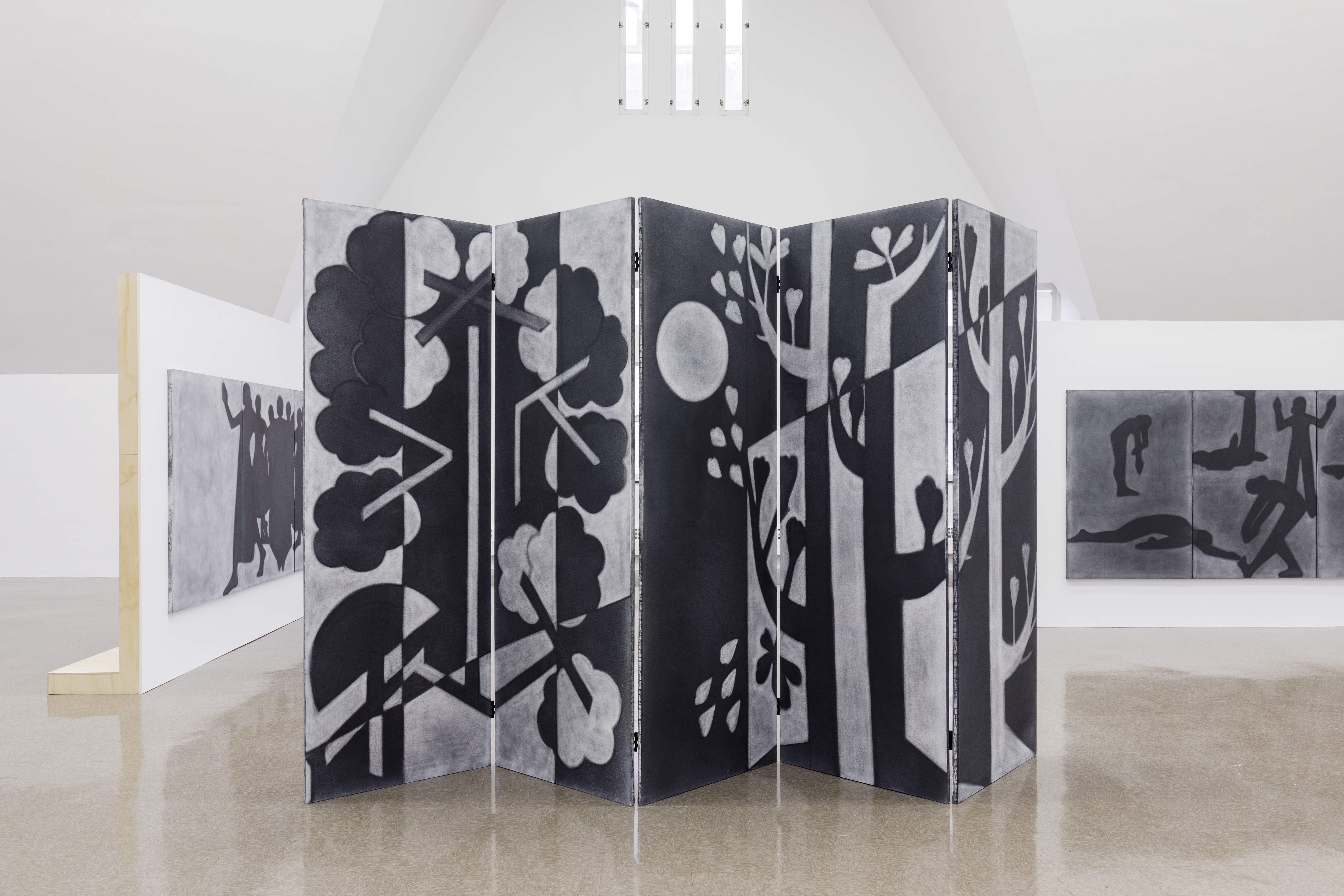
The Renaissance Society is currently closed due to COVID-19 safety measures. Check their website for the most up-to-date information.
The Renaissance Society kicked off the year with “In The Waiting Room,” a solo exhibition by Silke Otto-Knapp, a German artist based in Los Angeles. In these six monochromatic paintings, which make up a new body of work, Otto-Knapp meditates on the bodily gestures of dancers through an acute push-pull painting technique. At a distance, the paintings appear to be composed of a dry material, like pastel or charcoal. The toned grays and blacks carry an illusionistic appeal. Upon closer inspection, we notice wide brushstrokes spread across the canvas’s surface.
Throughout her career, Otto-Knapp, who teaches at the University of California, Los Angeles, has primarily worked in watercolor and gouache. Her early paintings were city and landscape pieces, often rendered with washes of color; she toyed with saturated pinks and blues that bled into the canvas, and metallic silver pigments that held a compelling allure. Her later work marks a departure from this tone. Otto-Knapp’s grayscale palette and flattened surfaces are a refusal of immediacy, for they compel the viewer to experience the paintings in a process of slow emergence.

Otto-Knapp approaches her paintings with methodological consistency. She first paints the canvas with black watercolor, then wipes the pigment away to reveal subdued grey values. The uses and meanings of the color black in contemporary painting signify a range of contexts. Consider the contemporary painter Kerry James Marshall, for example, who uses variations of black to probe racial markers and upend exclusionary beauty ideals in the history of western painting. Although Otto-Knapp doesn’t ascribe a racial identity to her painted subjects, their ambiguity brings forth her inclination to reveal the aesthetic and malleable qualities of carbon black, a pigment produced from the soot of burned oil. Her push-pull technique on canvas sends us on a journey of witnessing dancers preparing for a performance. The performative subject is emphasized by the placement of the painting on free-standing plywood panels across the gallery spaces, turning them into stage backdrops activated by the viewer.

Walking into the Renaissance Society, I confronted “Screen (Trees and Moon),” a free-standing fivefold panel facing the entrance. Two worlds simultaneously coexist on the panel. The hushed moonlit landscape on the three right folds is organic; it contains recognizable tree trunks with sprouting leaves. Illustrated on the two left folds are geometrically abstracted tree shapes with rigid rectangular branches. Standing in front of this painting, inspecting its frames and the black drips of watercolor on the canvas’s edges, I realized that the work cannot be viewed from one position: It is necessary to move in order to see the composition in its entirety. This dynamic viewing experience prepares the viewer to waltz across the room and further experience the quietude of Otto-Knapp’s compositions through the dynamism of one’s bodily movement.
Snaking between the panels conjured a memory of when I tested my body by enrolling in a contemporary dance course. This drive to be in touch with the body through dance choreography ended in a minor crisis. I had no prior knowledge or experience of contemporary dance, which resulted in my often unsuccessful attempts to follow the choreographer’s instructions. Twisting my limbs to convey expressive gestures and coordinating my moves with the music’s time signatures demanded a keen bodily awareness. Although I observed and attempted to imitate how my peers, all of whom were trained dancers, consciously moved across the dance floor, I was defeated by such demands, and ended up dropping the class. Otto-Knapp’s paintings cross a threshold that enables viewers to touch and feel the gestures embodied by the dancers, providing a visual vernacular that leaves a bodily impression on us.

Five of the six paintings are mounted on a constellation of panels arranged to face the walls. There is a certain disjunction between the works themselves, because although they fill the room, they do not turn towards or communicate with each other. The scholar Lambros Malafouris’s concept of material engagement theory posits that our sense of self is developed through bodily and mental engagement with objects in our world. I felt the sensation of an “extended self” in “In The Waiting Room.” Because the paintings are structured like a mobile stage set, the viewer is compelled to wonder about how to choreograph the works to create a different relationship between them. The high white ceilings of the Renaissance Society and the configuration of the panels with the interior summons the impression of being in suspension, waiting in anticipation of an event, perhaps a staged performance. Yet envisioning these paintings as stage sets can sometimes preclude the viewer’s straightforward entrance into the scenes of the paintings themselves. I began to wonder whether the paintings were mere backdrops to our movement, and how they might be seen in their own right.
I happened to see these works at night and in broad daylight, and preferably, I found it is best to experience them when the natural light shines through the northern window to illuminate these alluring scenes. The play of light and shadow heightens the solemnity in Otto-Knapp’s work. One might be tempted to pull out a phone and photograph these seemingly simple compositions, but their resonance lies in the impossibility of capturing them through a lens. Instead, the human eye is privileged here, for only in person are we capable of observing the slight variations of black that distinguish the figures and foliage from the painting’s background. Each painting intensifies when light floods the waiting room, and we are asked to enter these scenes, to anticipate how each one in itself might be a world contained.







